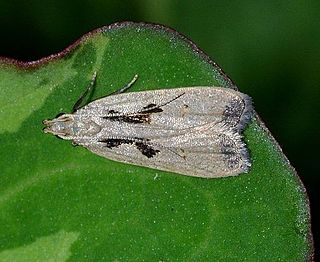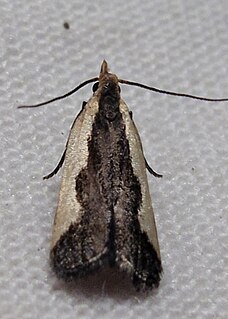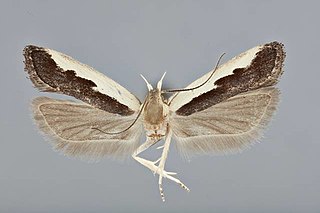
Helcystogramma is a genus of moths in the family Gelechiidae. The genus was erected by Philipp Christoph Zeller in 1877.

Dichomeris copa, the copa dichomeris moth, is a moth of the family Gelechiidae. It was described by Ronald W. Hodges in 1986. It is found in North America, where it has been recorded from Wyoming east to southern Ontario and Vermont, south to southern Illinois and Maryland.

Dichomeris laetitia is a moth of the family Gelechiidae. It was described by Ronald W. Hodges in 1986. It is found in North America, where it has been recorded from Illinois to Oklahoma, Mississippi and Maryland.
Dichomeris nenia is a moth in the family Gelechiidae. It was described by Ronald W. Hodges in 1986. It is found in North America, where it has been recorded from Texas, Arkansas, Alabama, Mississippi and Florida.
Dichomeris aglaia is a moth in the family Gelechiidae. It was described by Ronald W. Hodges in 1986. It is found in North America, where it has been recorded from Florida to Texas and in Louisiana, Mississippi, Alabama, North Carolina, South Carolina, Tennessee and West Virginia.

Dichomeris aleatrix, the buffy dichomeris moth, is a moth in the family Gelechiidae. It was described by Ronald W. Hodges in 1986. It is found in North America, where it has been recorded from southern Ontario south to Tennessee and north to Illinois.
Dichomeris bolize, or Glaser's dichomeris moth, is a moth in the family Gelechiidae. It was described by Ronald W. Hodges in 1986. It is found in the United States, where it has been recorded from Nebraska, Connecticut, Florida, Maryland, Massachusetts, New Jersey, New York, North Carolina and Texas.
Dichomeris illusio is a moth in the family Gelechiidae. It was described by Ronald W. Hodges in 1986. It is found in North America, where it has been recorded from Alabama, Mississippi and Florida.
Dichomeris mimesis is a moth in the family Gelechiidae. It was described by Ronald W. Hodges in 1986. It is found in North America, where it has been recorded from Texas, Mississippi and Florida.

Dichomeris xanthoa is a moth in the family Gelechiidae. It was described by Ronald W. Hodges in 1986. It is found in North America, where it has been recorded from Nebraska, Illinois, Indiana, North Carolina, Tennessee, Florida, Mississippi and Manitoba.
Dichomeris isa is a moth in the family Gelechiidae. It was described by Ronald W. Hodges in 1986. It is found in North America, where it has been recorded from Oklahoma, Arkansas, Florida, Georgia, Illinois, Kentucky, Massachusetts, Mississippi, Missouri, New Jersey, New York, North Carolina, Ohio, Pennsylvania, Tennessee, Texas and Ontario.
Dichomeris imitata is a moth in the family Gelechiidae. It was described by Ronald W. Hodges in 1986. It is found in North America, where it has been recorded from Texas and Mississippi.
Dichomeris offula is a moth in the family Gelechiidae. It was described by Ronald W. Hodges in 1986. It is found in North America, where it has been recorded from New York, Kentucky, Alabama, Mississippi, Louisiana, Michigan, Maine, West Virginia, British Columbia, Manitoba and Ontario.
Dichomeris crepida is a moth in the family Gelechiidae. It was described by Ronald W. Hodges in 1986. It is found in North America, where it has been recorded from Alabama, South Carolina, Florida, Mississippi and Louisiana.
Helcystogramma badia is a moth in the family Gelechiidae. It was described by Annette Frances Braun in 1921. It is found in North America, where it has been recorded from California and Nevada to southern British Columbia and Utah.
Helcystogramma casca is a moth in the family Gelechiidae. It was described by Annette Frances Braun in 1925. It is found in North America, where it has been recorded from southern Saskatchewan and British Columbia to Utah, Colorado and Oregon.
Helcystogramma chambersella is a moth in the family Gelechiidae. It was described by Mary Murtfeldt in 1874. It is found in North America, where it has been recorded from Pennsylvania, Illinois, Ohio, South Carolina, Tennessee, Louisiana, Mississippi, Florida, Oklahoma, Missouri, Texas, Arizona and California.
Helcystogramma fernaldella, or Fernald's helcystogramma moth, is a moth in the family Gelechiidae. It was described by August Busck in 1903. It is found in North America, where it has been recorded from Alaska, Yukon and Alberta, east across Canada and the northern United States to New Brunswick and New England. The habitat consists of fields, meadows and grasslands.

Helcystogramma melanocarpa is a moth in the family Gelechiidae. It was described by Edward Meyrick in 1929. It is found in North America, where it has been recorded from Nova Scotia to New Brunswick to South Carolina and to Texas.

A MONA number, or Hodges number after Ronald W. Hodges, is part of a numbering system for North American moths found north of Mexico in the Continental United States and Canada, as well as the island of Greenland. Introduced in 1983 by Hodges through the publication of Check List of the Lepidoptera of America North of Mexico, the system began an ongoing numeration process in order to compile a list of the over 12,000 moths of North America north of Mexico. The system numbers moths within the same family close together for identification purposes. For example, the species Epimartyria auricrinella begins the numbering system at 0001 while Epimartyria pardella is numbered 0002.





